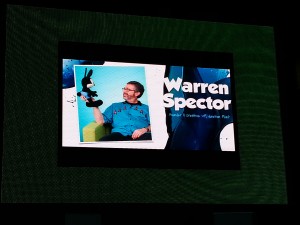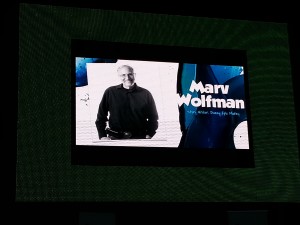Digifest 2012 with Warren Spector and Marv Wolfman
 On October 18, 2012 famed game designer Warren Spector and game writer for Epic Mickey 2, Marv Wolfman, delivered a keynote speech at Toronto’s Corus Quay, as part of Digifest 2012. Focusing mainly on the upcoming Epic Mickey 2: The Power of Two, the talk detailed Warren Spector’s experiences with the creation process of both the original Epic Mickey and its sequel. Marv Wolfman focused more on his experience of writing for the game, which was interesting and enlightening, particularly with his descriptions of transitioning from comic to videogame writing.
On October 18, 2012 famed game designer Warren Spector and game writer for Epic Mickey 2, Marv Wolfman, delivered a keynote speech at Toronto’s Corus Quay, as part of Digifest 2012. Focusing mainly on the upcoming Epic Mickey 2: The Power of Two, the talk detailed Warren Spector’s experiences with the creation process of both the original Epic Mickey and its sequel. Marv Wolfman focused more on his experience of writing for the game, which was interesting and enlightening, particularly with his descriptions of transitioning from comic to videogame writing.
The talk began with a quick look back at how Epic Mickey was received; perhaps the most interesting fact was that the original game was played by an almost 50/50 split between children and adults, and also by males and females. Considering the favourable critical reception for the game, it’s not surprising that Epic Mickey was the best-selling single platform game in Disney Interactive history, and so Warren Spector went on to detail just how the game was initially envisioned and then created.
With such a wide history as Disney’s, it’s understandable that the development team didn’t need much in the way of inspiration. In terms of making a game around the central character of Mickey Mouse, it was helpful that he is so iconic, yet also incredibly open to change. The problem was making him into a cool avatar, and a character that people could view on the same level as Mario, Sonic, or Ratchet, particularly as Mickey is labelled by many as being solely for children. The main question the developers needed to ask was just why Mickey was still so dominant eighty years after his creation, when other creations from the same era have been all but forgotten. To respond, Warren Spector brought up a series of images from throughout Mickey’s history, showing him in a variety of guises and environments. The answer, he explained, was that Mickey was adaptable, to both audience and era, meaning that children of the 80s or 90s had the same love for him as children from the 20s and 30s did.
The next topic of discussion was the troubles that the team had with deciding how to animate Mickey. Being a ‘bean-shaped’ character, it was difficult to keep Mickey looking cool, and also making sure that his thin arms and legs didn’t just disappear behind this ‘bean’ in the center of his body. At this point the audience were shown some amusing tech demo footage of just how the team went about answering this question, including some fantastic animation models of just how the game’s version of Mickey came to be. The following problem was how to deal with Mickey’s ears. Mickey’s classical design is to have 2D ears that always face forward. Obviously in a 3D environment with a rotating camera, this is an incredibly difficult thing to model. Even making Mickey look good and be able to convey emotion from behind was an issue encountered by the design team, a problem which was encountered again with Oswald, who had never even been seen in 3D.
We were then treated to an amusing anecdote which detailed the process of including Oswald the Lucky Rabbit within Epic Mickey. Oswald was the first character Walt Disney created during his time with Universal, and due to contractual wrangling, Disney lost the intellectual property rights to the character, leading to the creation of Mickey Mouse. 78 years after losing the character, the then President of Disney, Bob Iger, went to NBC and managed to trade to property rights for Oswald back to Disney in exchange for sports broadcaster Al Michaels.
 As well as including such famous characters as Mickey Mouse and Goofy, Warren Spector outlined just how other characters had come to be included within the game. Every character you see in Epic Mickey, including, surprisingly enough, the Phantom Blob, has appeared at some point in a Disney creation, although some alterations for certain characters were made. This segued into an explanation of other design decisions related to the game that didn’t make it to the final product, including inky footprints following Mickey, lampposts that spoke to you as you approached, and a selection of maps and environments that weren’t quite up to scratch.
As well as including such famous characters as Mickey Mouse and Goofy, Warren Spector outlined just how other characters had come to be included within the game. Every character you see in Epic Mickey, including, surprisingly enough, the Phantom Blob, has appeared at some point in a Disney creation, although some alterations for certain characters were made. This segued into an explanation of other design decisions related to the game that didn’t make it to the final product, including inky footprints following Mickey, lampposts that spoke to you as you approached, and a selection of maps and environments that weren’t quite up to scratch.
Warren turned to Epic Mickey 2 to discuss how some of these the issues present in its predecessor have been rectified in the title and how the design team has spent time on fixing the camera issues (one of the biggest critical issues with the first game), maximising the influence of choice and consequence within the game, and adding voice acting to the sequel for every character – something that was missing in Epic Mickey, aside from in a couple of cutscenes. We were shown the intro video for the new game, which detailed how Wasteland is suffering from Earthquakes, and how the Mad Doctor (who now sings all of his lines) shows up to save the day and offer his help. Epic Mickey 2 is due to contain plenty of songs throughout the game, and will feature new areas for the series based on such classic Disney properties as Fantasia and Snow White and the Seven Dwarves.
Marv Wolfman took the stage, to discuss his experiences writing for the game, and writing the first words for the character of Oswald the Lucky Rabbit, since Oswald hadn’t been on-screen since the era of silent movies. He discussed the conversations that Warren Spector and himself had had when trying to nail down a particular voice for the character, and at this point Warren explained that he’d always imagined Oswald with a Brooklyn accent, mainly due to his swagger and actions from the first game. Being from New York himself, Marv says that he found it quite easy to bring such a personality to Oswald, and because of this, he found writing Oswald an enjoyable experience, because he can be everything that Mickey can’t, such as angry or jealous. He detailed the writing process, explaining how the dialogue has to be written in the form of an Excel spreadsheet, a task which is particularly difficult.
 Wolfman comes from a comic background, having worked for both Marvel and DC, and was in fact the founding editor of the Disney Adventures magazine, which heavily featured stories revolving around Mickey Mouse. Wolfman was approached by Spector at a convention in Texas, where both spoke on a panel regarding videogame writing.
Wolfman comes from a comic background, having worked for both Marvel and DC, and was in fact the founding editor of the Disney Adventures magazine, which heavily featured stories revolving around Mickey Mouse. Wolfman was approached by Spector at a convention in Texas, where both spoke on a panel regarding videogame writing.
As the talks drew to a close, there was a brief Q&A session with both Spector and Wolfman, and included questions on the writing process (Wolfman didn’t actually see the game until this event), how co-op was integrated into this game (it was there from the beginning, not tacked on at a later date), whether Epic Mickey 2 would support PlayStation Move or Kinect (Move yes, because of the paintbrush mechanic; Kinect, no), and whether moving from a Wiimote to a standard controller made for a lesser experience (no, but it changes the way people play the game).
All in all, the panel discussion lasted for just over an hour, and was filled with interesting anecdotes and a lot of pertinent information for budding game designers and writers. Warren Spector and Marv Wolfman are both obviously very proud of Epic Mickey 2, and from what was shown here, deservedly so, as the game seems to improve on the first in almost every way. Environments are more detailed and varied, allowing the characters to talk adds a whole new emphasis to in-game immersion, and the new gameplay aspects, particularly the inclusion of co-op, mean that Epic Mickey 2 is a more complete package than the original. I, for one, can’t wait to play the sequel, and having the creation process for both games explained and detailed by both its creator and its writer was a fantastic experience that I wish I could experience for many more games.
About This Post
